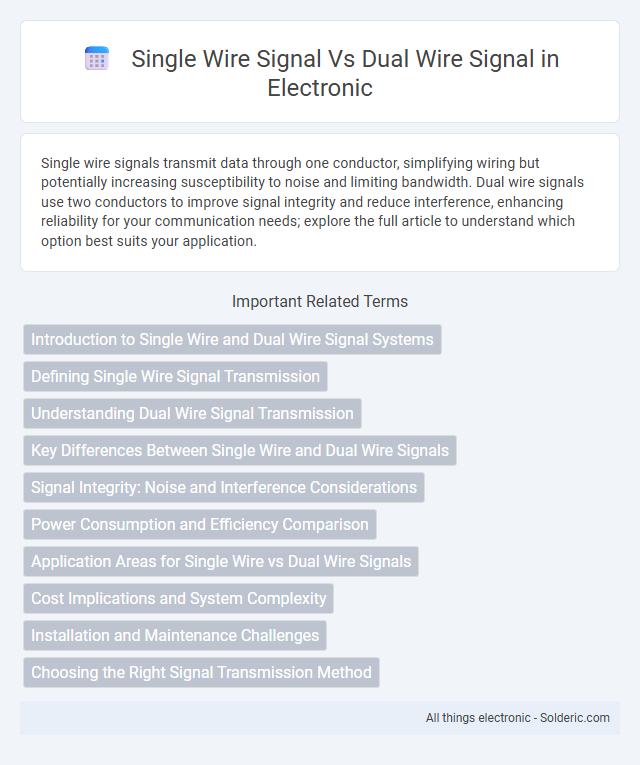Single wire signals transmit data through one conductor, simplifying wiring but potentially increasing susceptibility to noise and limiting bandwidth. Dual wire signals use two conductors to improve signal integrity and reduce interference, enhancing reliability for your communication needs; explore the full article to understand which option best suits your application.
Comparison Table
| Feature | Single Wire Signal | Dual Wire Signal |
|---|---|---|
| Number of Conductors | One | Two |
| Signal Integrity | Lower, more noise susceptible | Higher, improved noise immunity |
| Common Applications | Simple sensors, basic communication | Differential signaling, advanced communication |
| Cost | Lower | Higher |
| Data Rate | Lower | Higher |
| Noise Immunity | Minimal | Excellent (cancels common-mode noise) |
| Implementation Complexity | Simple | Moderate |
| Examples | UART, single-ended analog signals | RS-485, CAN bus, USB Differential pairs |
Introduction to Single Wire and Dual Wire Signal Systems
Single wire signal systems transmit data using a single conductive path, reducing wiring complexity and installation costs, ideal for simple sensor connections or low-speed communication. Dual wire signal systems utilize two conductors, enabling differential signaling that improves noise immunity and signal integrity over longer distances and in electrically noisy environments. Understanding these systems helps you choose the optimal wiring configuration based on your specific application requirements.
Defining Single Wire Signal Transmission
Single wire signal transmission involves sending electrical signals through one conductor, typically using the ground or chassis as the return path to complete the circuit. This method simplifies wiring and reduces costs but can be more susceptible to noise and signal degradation over long distances compared to dual wire systems. Single wire systems are common in automotive and low-speed communication applications where minimal wiring is essential.
Understanding Dual Wire Signal Transmission
Dual wire signal transmission offers enhanced noise immunity and signal integrity by utilizing two conductors to carry complementary signals, effectively reducing electromagnetic interference (EMI). This method employs differential signaling, where the receiver interprets the difference between the two wires, improving data accuracy and transmission distance compared to single wire signaling. Common in high-speed communication protocols such as RS-485 and CAN, dual wire systems enable robust and reliable data exchange in electrically noisy environments.
Key Differences Between Single Wire and Dual Wire Signals
Single wire signals transmit data through a single conductor, reducing complexity and cost but increasing susceptibility to noise and signal degradation. Dual wire signals utilize two conductors, often providing differential signaling that enhances noise immunity and improves signal integrity over longer distances. Understanding these key differences helps you choose the appropriate wiring method based on your system's requirements for reliability and performance.
Signal Integrity: Noise and Interference Considerations
Single wire signal transmission is more susceptible to noise and electromagnetic interference (EMI) due to the lack of a dedicated return path, which can degrade signal integrity especially over longer distances. Dual wire signals, often implemented as differential pairs, improve noise immunity by using complementary signals that cancel out common-mode noise, enhancing signal robustness and allowing higher data rates with lower error rates. This differential signaling approach reduces crosstalk and electromagnetic emissions, making it ideal for high-speed communication in electrically noisy environments.
Power Consumption and Efficiency Comparison
Single wire signal systems generally consume less power due to simpler circuitry and reduced conductor material, resulting in lower resistance and minimal energy loss. Dual wire signal configurations can lead to higher power consumption because of increased current flow and complexity in signal transmission requiring more robust drivers. Efficiency in single wire setups is optimized for low-power applications, while dual wire systems often prioritize signal integrity and noise reduction at the cost of increased energy use.
Application Areas for Single Wire vs Dual Wire Signals
Single wire signals are predominantly used in simple sensor interfaces, automotive communication networks like LIN (Local Interconnect Network), and low-speed data transfer scenarios due to their cost-effectiveness and reduced wiring complexity. Dual wire signal systems find extensive application in high-speed data communication, industrial automation, and differential signaling environments such as RS-485 and CAN (Controller Area Network), providing enhanced noise immunity and signal integrity. The choice between single and dual wire signals depends on factors such as required data rate, noise environment, and system complexity.
Cost Implications and System Complexity
Single wire signal systems generally lower cost implications due to fewer materials and simpler installation requirements, reducing overall expenses. Dual wire signal configurations increase system complexity by requiring additional wiring and more intricate routing, which can elevate labor and maintenance costs. Your choice depends on balancing the benefits of reduced cost from single wire setups against the enhanced reliability and noise resistance offered by dual wire systems.
Installation and Maintenance Challenges
Single wire signal systems simplify installation by reducing wiring complexity and material costs, making them ideal for straightforward and space-constrained setups. Dual wire signal systems require more intricate wiring and connectors, increasing installation time and the potential for wiring errors. Maintenance of dual wire configurations can be more demanding due to the need to check both wires for continuity and interference, whereas single wire systems streamline troubleshooting but may face limitations in signal quality and noise immunity.
Choosing the Right Signal Transmission Method
Single wire signal transmission offers a simpler, cost-effective solution ideal for short distances and low-interference environments, while dual wire signal transmission provides enhanced noise immunity and signal integrity, suitable for longer distances and more complex systems. When choosing the right signal transmission method, factors such as signal frequency, environmental noise, cable length, and required data integrity must be evaluated. Dual wire configurations, including differential signaling, are preferred in industrial automation and high-speed communication due to their superior resistance to electromagnetic interference (EMI).
single wire signal vs dual wire signal Infographic

 solderic.com
solderic.com